“The Sue Cycle”
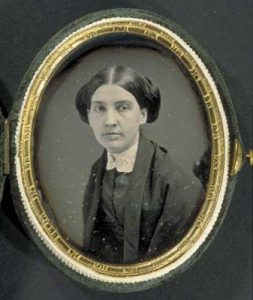
Susan Dickinson, n.d.
One of the persons we KNOW Dickinson chose for her selective society was Susan Huntington Gilbert Dickinson, a girlhood friend of Dickinson's and eventually her sister-in-law. We dedicate this week to exploring her significance in Dickinson’s personal and poetic lives. It is not clear whether Sue, as Dickinson usually refers to her, chose Dickinson back or reciprocated as the full confidante, soul sister, even lover that Dickinson wanted. But their importance to each other is indisputable.
Sue was born nine days after Dickinson on December 19, 1830 and died twenty-seven years almost to the day of Dickinson's death on May 12, 1913. From a struggling family and with dreams of betterment, Sue loved books, reading, art and poetry. Orphaned at a young age, she was raised by her aunt and came to live in Amherst in 1850, where she met Dickinson and, for the next decade, their intimacy flourished.

Yale University Archives
Dickinson’s early letters to Sue are nothing short of delirious. In one of the most thorough considerations of their association, Judith Farr speculates that Sue took the place of Dickinson’s girlhood friend and crush, Abiah Root, when Abiah married and stopped responding to Dickinson’s erotic importunities.
Then, on July 1, 1856, Sue married Austin, Dickinson’s brother, a match Dickinson encouraged, thinking it would bind Sue more firmly into the family, especially when their father built the couple an Italianate villa dubbed “the Evergreens” next door to the Homestead. Dickinson’s upstairs window faced both the road and the Evergreens where she could watch Sue’s comings and goings.
Sue was a fit interlocutor for Dickinson and there is evidence that they shared profound interests in reading, writing, gardening, recipes, and even acted as editors for each other’s poetry, as in the case of “Safe in their Alabaster Chambers,” detailed below. But Sue was mercurial, worldly and socially ambitious, and soon became busy with the birth of her first child. Scholars differ on just what happened, but in the Fall of 1861, as Farr narrates it, Sue sent a letter to Dickinson, folded up tight and marked “private,” apologizing for her silence, commiserating with Dickinson’s suffering (the “terror” Dickinson tells Higginson she experienced “since September”) and disclosing her own
sorrow that I never uncover. If a nightingale sings with her breast against a thorn, why not we?
she asks. This note captures the literary quality of their relationship.
In a message Dickinson sent across the lawn to the Evergreens later in 1862, Dickinson included the poem, “Your Riches – taught me – Poverty” (F418, J299), with the words,
Dear Sue– You see I remember–Emily.
It’s as if their deep love and profound importance to each other exist now in memory, but they provided Dickinson with her great themes of loss and suffering. We will discuss this poem and others from the “Sue Cycle” of poems Farr identifies in the poems section in order to plumb the vast and sometimes underplayed importance of Sue in Dickinson’s artistic life.
“We need humility”
Springfield Republican
INTERNATIONAL
Britain continues to deliberate, but so far refuses to recognize the Confederacy or aid their cause in any way, which eases the Union’s nerves on the matter.
The war for subjugation in Mexico continues, and the Union Senate finally decides to reinvigorate the Monroe Doctrine and ally itself with Mexico against Britain, France, and Spain. Previously, there were worries that getting involved in the conflict would take away resources from the Civil War and a free Mexico would enable the South to pull them into the war, but with the South’s “suppression now well and assured,” these worries disappear.
NATIONAL
Review of the Week: Progress of the War. The Union continues to report back on sweeping victories that keep the Confederacy’s armies retreating, “crushed,” and destitute in morale. Tennessee is under General Ulysses S. Grant’s martial law and Missouri is now “swept clean,” and reports say the Union has occupied Fort Donelson and Nashville, which cuts off vital road systems that connect the Confederacy. General Price’s army is “used up,” and the civilians in the South “accept their fate” and submit to the Union’s government rule.
An index of the importance of this victory, and its costs, is Herman Melville’s long poem, “Donelson,” published in Battle-Pieces and Aspects of the War (1866). The detailed account of the successful Union siege of the Confederate Fort concludes on a less celebratory note with “wife and maid” reading “the death-list” while the narrator intones:
Ah God! may Time with happy haste
Bring wail and triumph to a waste,
And war be done;
The battle flag-staff fall athwart
The curs'd ravine, and wither; naught
Be left of trench or gun;
The bastion, let it ebb away,
Washed with the river bed; and Day
In vain seek Donelson.

(Photo Credit: Library of Congress)
Jefferson Davis was inaugurated as the president of the Confederacy for six years last Saturday, and during the ceremony it was reported that he received updates on Nashville.
“Washington’s Day” was “never before as universally and enthusiastically celebrated” as it was this week in the Union. It symbolized the strength of the Union and the country as a whole, and boosted morale even higher than the previous string of victories.
A Violent, Wintry Storm. A series of peculiar storms hit Massachusetts, including hurricanes and snow storms within the course of “three to four days.” This may be the “fatal weather” Dickinson refers to in a letter (L 254) to her cousin, Frances Norcross, written at this time.
Life in Washington. As Seen Through New Spectacles. This week’s “Life in Washington” is a walk through the “grand” streets of the National Mall. The author tells us of the history of the layout, designed by Christopher Wren, and compares it to other famous cities: New York, London, and Paris in terms of style and space. The reader explores Pennsylvania Avenue and its history as they walk with the author down the visual space, with the White House as the last stop.
We learn the history and architectural inspiration for the White House, both inside and out, but then the author inevitably strays to the recent death of eleven-year-old William “Willie” Wallace Lincoln (February 20, 1862) and the impact it had on the family and the country. The author (perhaps a woman, as the other “Life in Washington” installments suggest) muses on Mary Todd Lincoln’s distress about her son, and the criticism she received because of such devastation. The author ridicules all the gossip about Mary Lincoln that unfairly criticizes her, as it
sharpens the scalpel which cuts through every fibre of her mental, moral, and physical frame. If she were an angel fresh from the sky she could not satisfy the requirements of narrow ignorance and petty malice.
The author reiterates that “we need humility” in this time, kindness for others and for the grieving Lincoln family, as they experience distress. This column may be a response to last week’s “A Visitor in Washington,” which expressed vehement dislike for women as irrational and fomenting evil, especially those Southern women who are the supposed root of the “wild and wicked rebellion”—the author recounts the story of a man who sees trouble and asks, “who is she?” thus ascribing every problem encountered to woman.
When a Wife Should be at Home. This little column is a companion piece to last week’s “When a Husband Should be Absent from Home” (on washing and cleaning days, when the child cries and when your wife’s female friends come to visit) and lists some traditional duties of “mistresses of the household” at the time:
The wife may go out for light and air, and also for her little round of social duties, of friendship or beneficence. She may go out for merchandise and marketing, as the mother-bird explores every nook for the snug upholstery that lines her nest, and the dainty morsels for which the birdlings flutter and call. She may go out, too, as the robin does, for food for herself; that she may return with a clearer mind and a larger heart, a fresher cheek and a more elastic step; yea, in some instances, where such an improvement is possible, with a more equable temper than before. For these purposes the prayer meeting, the lecture, the concert, the soiree and sewing-circle are not to be despised. But all these wanderings should be subordinate and occasional, the exception and not the rule.
The bird metaphors are particularly relevant to Dickinson and Sue. Here they are little creatures, delicate and homely. In her early poetry about Sue, Dickinson used bird metaphors as well, but these birds were singers and built nests and carry very different connotations: of strength and wonder, instinct and great importance, vital to nature and life, sometimes divine.
“Sue —Forever More!”
This week, Dickinson received a very excited letter from Susan Dickinson, discussing the appearance of “Safe in their Alabaster Chambers” in the Springfield Daily Republican on March 1, 1862. Entitled “The Sleeping,” the poem was heavily edited and regularized and published anonymously (see below for an image of the original printing):
The Sleeping.
Safe in their alabaster chambers,
Untouched by morning,
And untouched by noon,
Sleep the meek members of the Resurrection,
Rafter of satin, and roof of stone.Light laughs the breeze
In her castle above them,
Babbles the bee in a stolid ear,
Pipe the sweet birds in ignorant cadences:
Ah! What sagacity perished here!
This poem is key in illustrating the profound personal and poetic connection between Dickinson and Sue. The myth goes that Dickinson wrote in solitary exile in her upstairs bedroom. And for many years, family members and editors have ignored or downplayed her intense connection to Susan Dickinson. But Martha Nell Smith and Ellen Louise Hart argue in their edition, Open Me Carefully: Emily Dickinson's Intimate Letters to Susan Huntington, that the material evidence shows that Dickinson and Sue, living next door to each other, sent poems and other writings back and forth for commentary and critique.
“Safe in their Alabaster Chambers” is the prime example. In 1859, Dickinson sent a draft that was close to the printed version quoted above to Susan, who thought the second stanza inadequate. Dickinson then sent her a new version with a new second stanza,
Grand go the Years – in the
Crescent – above them –
Worlds scoop their Arcs –
And Firmaments – row –
Diadems – drop – and Doges -
surrender –
Soundless as dots – on a
Disc of snow -
But Susan again disliked it, writing in reply in one of the rare surviving correspondences between the two women,
I am not suited dear Emily with the second verse … it just occurs to me that the first verse is complete in itself it needs no other, and can’t be coupled –.
One last (known) time, Dickinson wrote an alternate second stanza and sent it to Susan, asking, “Is this frostier?” Susan chose to submit the first version to Bowles for printing in the Republican, but when Dickinson wrote to Higginson in April 1862, she included the poem with the second stanza beginning “Grand go the years.”
In the same letter in which Dickinson sent the “frostier” final stanza, she praises Susan’s eye for poetry and criticism, saying “I know it knows,” and that
Could I make you and Austin – proud – sometime – a great way off – ‘twould give me taller feet -,
a line that Susan would remember well into the 1880s when she wrote it down while working on compiling a book of Dickinson’s writings. Her daughter would finish that work and publish it in 1914 as The Single Hound, which Kate Anthon, another long-time friend of the two women, called
a volume as a memorial to the love of these “Dear, dead Women.”
The material evidence Hart and Smith offer is the more than 500 poems, letters and other writings Dickinson sent to Susan over their forty-year correspondence, way more than she sent to her next most important correspondent, Thomas Higginson. Furthermore, especially in the early years, the poems were mostly in pencil and on scraps of plain paper, unlike the ink and gilt-edged stationary Dickinson used for copying out poems in the fascicles or sending poems in letters. The drafts of “Safe in their Alabaster chambers” she sent to Susan were clearly working drafts and Dickinson invited feedback, which Susan happily and somewhat haughtily provided. But after this experience, we have no evidence of Dickinson soliciting feedback from Sue, and in April 1862, she looked for a new “preceptor” in Thomas Wentworth Higginson.
Susan was a good mirror for Dickinson: passionate, worldly, intellectually gifted, an insatiable reader and a devotee of poetry. She also wrote a few critical essays and reviews herself, some of which she sent as Letters to the Editor, and she frequently wrote to Samuel Bowles, Thomas Wentworth Higginson, and William Hayes Ward — all influential editors of their day. She submitted some of Dickinson’s poems to be printed in different newspapers as well, and published four short stories and at least two of her own poems. She championed women writers throughout her life, as evidenced by a lengthy review of the early work of Harriet Prescott Spofford she sent to the Editor of the Republican in 1903.
Sue's obituary for Dickinson, which appeared in the Springfield Republican on May 18, 1886, and which Higginson thought good enough to serve as the introduction to the 1890 volume of Poems (but Mabel Todd rejected), is considered the first important critical evaluation of Dickinson’s work.
Below “The Sleeping” was printed one such poem that is most likely Susan’s, entitled “The Shadow of Thy Wing”:
 Sue most likely sent her drafts to Dickinson for editing as well, but most of the women’s correspondence is lost. What remains, however, reveals much about their relationship.
Sue most likely sent her drafts to Dickinson for editing as well, but most of the women’s correspondence is lost. What remains, however, reveals much about their relationship.
Dickinson and Susan were particularly close for almost their entire lives, displaying what modern readers would label as an intense, passionate romance. Their letters are frequently erotic, and Dickinson romanticizes Susan, calling her Darling, Dear Sue, Sweet Sue, and Dollie in the most passionate of cases. During the nineteenth century, such intensely affectionate relationships between same-gender friends were commonplace. See, for instance, Carroll Smith-Rosenberg’s classic essay on the subject, “The Female World of Love and Ritual: Relations between Women in Nineteenth-Century America” (1975).
Close friendships used romantic imagery of flowers and longing, physical intimacy of kisses and hugs, and loving affectionate names like “dearest,” “darling,” “my angel,” “sweet,” “lover,” etc. For Dickinson scholars Martha Nell Smith and Ellen Louise Hart, however, Dickinson and Susan’s letters and relationship indicate a love that
surpasses in depth, passion, and continuity the stereotype of the “intimate exchange” between women friends of the period.
Some scholars see them as lesbians; others see Dickinson as queer.
Dickinson likens Susan to Eden, Cleopatra, imagination, calls her the “Only Woman in the World,” and describes her love for Susan as an “endless fire.” Hart and Smith point out that Austin was clearly jealous of Susan and Dickinson’s relationship after they were married, and Susan even accused him of “interfering” with their letters, to which he responded quite defensively:
As to your deprivation of “Spiritual converse” with my sister – I Know Nothing … So you will not suspect me of having interfered with your epistolary intercourse with her.
(Note: “intercourse” did not carry a sexual connotation at the time). Dickinson also equates herself with Austin in relationship to Susan, in the famous letter in which she says: “I guess we both love Susie just as well as we can” that casts them both as her suitors. See also the poem, “The Malay took the Pearl” (F451A, J452),” which scholars have read as a love triangle composed of Austin–Sue–Emily.
Another fascinating element in this story is that the material remains of Dickinson and Susan’s relationship suffer from heavy mutilation, making it hard to discern what they meant to each other. Someone, most likely Austin or his lover of twelve years, Mabel Loomis Todd, whom Susan at first befriended but eventually snubbed and completely rejected, painstakingly erased, masked, or changed references to Susan in most quasi-romantic contexts. For example, in printing, “Her breast is fit for pearls” (F121A, J84), Todd replaced Susan with Mary Bowles as the recipient. The opening salutation, “To Sue,” of “The face I carry with me -” (F395A, J336) was erased, and in the suitor letter to Austin, “I guess we both love Susie,” the “S” and “ie” are erased to produce a familial love of “us.” By contrast, Sue is allowed to appear in other letters not romantically inclined.
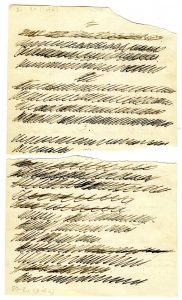
The most striking mutilation of a poem occurs in the “B” version of “One sister have I in our house” (F 5A, B, J14). A great deal of angry energy has been expended to erase the importance of Sue to Dickinson, and as a counter to that, we have chosen our cluster of poems from those poems scholars speculate were written to and about the incomparable Sue.
Reflection
Victoria Corwin
 The relationship between Emily and Sue always fascinated me. I am usually the token queer theorist in the room when anything comes up in one of my many College English classes, so I had a lot to say on the subject whenever a “Sue poem” (as we’ve taken to calling them) came up in our studies. But because we were aware of the prevalence of such close same-gendered relationships, thanks to Carroll Smith-Rosenberg’s essay and the “cult of true womanhood,” I felt a bit skeptical of applying queer theory to the time period.
The relationship between Emily and Sue always fascinated me. I am usually the token queer theorist in the room when anything comes up in one of my many College English classes, so I had a lot to say on the subject whenever a “Sue poem” (as we’ve taken to calling them) came up in our studies. But because we were aware of the prevalence of such close same-gendered relationships, thanks to Carroll Smith-Rosenberg’s essay and the “cult of true womanhood,” I felt a bit skeptical of applying queer theory to the time period.
Then, I came across “One Sister have I in the house -”
Reading Martha Nell Smith’s introduction to the Dickinson Electronic Archive’s exhibit about mutilation in the Dickinson corpus, my whole world changed. I had only ever worked with the manuscript when looking for frequent Dickinson word alternations or connotations of different kinds of stationery, but never considered cuts, erasures, inks, much less destructions of any kind. I couldn’t imagine they existed—that, of course, no one would intentionally ruin a real life Dickinson manuscript, how silly.
But the image of “One Sister” sewn into Fascicle 2 (copy F5B) looks like this:
Utterly defaced.
Fascicle 2 is the heaviest mutilated fascicle out of the 40 we have, with six poems missing, all by the hand of the mutilator(s) that meticulously and very intentionally deleted “One Sister” from the fascicle and tried to delete it from Dickinson’s work completely. The mutilator (jealous Austin, inferior sister Vinnie, or Sue’s mortal enemy Mabel?) struck through the poem in ink, cut it out of the fascicle, and ripped it again and again in multiple places so that an editor could not fit the pieces back together again, ever. We have the full poem only because Emily sent a copy to Sue, which she guarded down to her last breath.
How is this not queer?
The heaviest deletion violently cancels line 27, “Sue – forevermore!” which indicates that this line held the most weight for the mutilator. Sue is the most important element to delete, whether due to Austin’s failing marriage, Vinnie’s jealousy, Mabel’s hatred, or a general dislike for Sue post-1880s that sprang from Mabel and Austin’s public affair. The exact motivation, however, is irrelevant, because every one of the possible motivations ultimately stems from the same basic queer issue: Emily’s love for Sue.
Since having such a revelation, I’ve been primarily concerned with mutilations and how they unintentionally reveal the deeper politics of Dickinson’s relationships with others. I’m fully convinced that Smith and Hart are right when they say “One Sister” indicates a love that
surpasses in depth, passion, and continuity the stereotype of the “intimate exchange” between women friends of the period,
but I’m not entirely sure what that means yet—whether and which queerplatonic, romantic, or sexual labels apply to either of them.
All I know is that I will never not look at a manuscript ever again, and always check poems or letters for damage. Signs of tampering carry a deeper meaning than words alone ever could, and I have a feeling the heavily deleted line “Sue – forevermore!” will haunt Dickinson studies (and me) for a very long time.
Bio: Victoria Corwin is a Dartmouth class of ‘19 and a student of English and Classical Archaeology. She edits the Stonefence Review and writes fiction and poetry whenever the time is right. A voracious reader and a devout Dickinson scholar, she swears by adjectives, Open Me Carefully, and “One Sister have I in the house -,” and thinks words only grow more powerful when crossed out.
Sources
Historical:
Springfield Republican, volume 89, no. 9, Saturday, March 1, 1862.
Biographical:
Amherst Emily Dickinson Collections
Emily Dickinson’s Correspondences with Susan Dickinson, DEA
Farr, Judith. The Passion of Emily Dickinson. Harvard University Press, 2004.
Leyda, Jay. The Years and Hours of Emily Dickinson. Yale University Press, 1960.
Smith, Martha Nell, and Ellen Louise Hart, editors. Open Me Carefully: Emily Dickinson’s Intimate Letters to Susan Huntington Dickinson. Paris Press, 1998.
Mutilations: What Was Erased, Inked Over, and Cut Away, DEA
Writings by Susan Dickinson, DEA
–


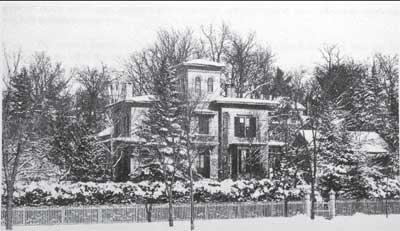
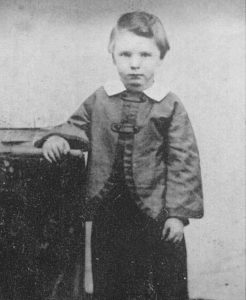
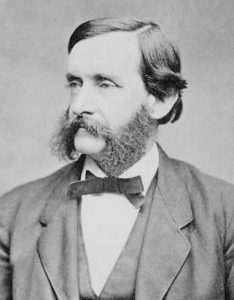

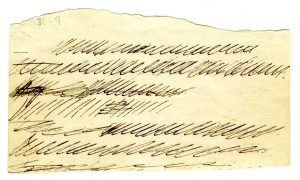
This is a great subject. It’s important to mention Martha Nell Smith’s & Ellen Louise Hart’s OPEN ME CAREFULLY (ED intimate letters do SD). No matter what happened between them, the fact is hundreds of ED poems where sent to Sue, many of them among the more enchanting love poems ever written.
We at White Heat agree, which is why we felt it was important to do this post. We will be doing more on Sue in future posts and are planning a post on “gender trouble” and “queerness,” so keep reading!
Almost as awesome as this topic, and it’s truly one of the biggies in all of American letters, is that Abiah Root is memorialized in pictures kept at Yale simply for being the chumpy recipient of some of Emily’s most moving correspondence.